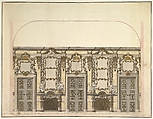Design for the Salon of the Pleasure Pavilion, Favorita, at Ludwigsburg, 1718
Donato Giuseppe Frisoni Italian
Not on view
This impressive drawing shows a design for a Salon, meant for the pleasure pavilion and hunting castle called ‘Favorita’ in the park of the Palace of Ludwigsburg. The rich, almost fully symmetrical design is executed in a late Baroque style and is decorated all over with gilt stucco ornaments. The latter were an (North) Italian specialty and it leaves no wonder that this interior was designed by an Italian architect and stucco artist: Donato Giuseppe Frisoni. He came to Ludwigsburg in 1709 as a partner of Tommaso Soldati (Bergamo, active first quarter of the 18th century), but by 1715 he was named head architect by his patron Duke Eberhard Ludwig of Württemberg. This design for a Salon at the pleasure pavilion Favorita was made in 1718 and carries the handwriting of both men. In the inscription below, Frisoni describes the room and the materials it will be executed in: glass mirrors, marble and stucco. He also mentions that the ceiling was to be painted in fresco. At the lower left, the Duke has left his initials as a sign of his approval of the design.
Due to rights restrictions, this image cannot be enlarged, viewed at full screen, or downloaded.



